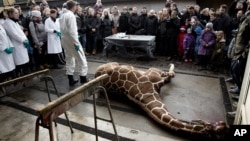COPENHAGEN —
Copenhagen Zoo's scientific director and other staff have received death threats after a healthy giraffe was killed to avoid inbreeding among the long-necked beasts there, the zoo said on Monday.
But director Bengt Holst said it was the right decision and he would be ready to do the same with another animal if needed.
The death of Marius, an 18-month-old male shot on Sunday and then dissected in front of crowds at the zoo, has created a uproar among animal lovers in Denmark and abroad.
“I got direct threats against the zoo, me and my family,” Holst said. One caller who telephoned in the middle of the night told him that he and his family deserved to die.
A zoo spokesman said other staffers had also been threatened but gave no further details.
Copenhagen Zoo's giraffes are part of an international breeding program that aims to maintain a healthy giraffe population in European zoos by ensuring that only unrelated giraffes breed.
“If an animal's genes are well represented in a population, further breeding with that particular animal is unwanted,” Holst said. “We could face the same problem with an elephant if there are too many males.”
Petition pleads for Marius
Marius was killed despite the pleas of thousands who signed online petitions to save him. He was given his favorite breakfast of rye bread and then shot.
After an autopsy, some meat from Marius's carcass was fed to other zoo animals and some was sent to research projects in Denmark and abroad for study.
Camilla Bergvall, vice chairwoman of Animal Rights Sweden, said it was common for zoos to kill healthy animals because they were not suitable for breeding, the zoo lacked room for them or there was little public interest in them.
“Zoos have to think about their revenues,” she said. “It is important to understand that this is not just about Marius. It happens quite often that healthy animals are killed.”
Bergvall said keeping species in zoos caused the individual animals to suffer. Breeding animals for captivity created the limited gene pool problem that led to Marius's death.
“The best thing is not to breed animals for people to look at,” she said.
But director Bengt Holst said it was the right decision and he would be ready to do the same with another animal if needed.
The death of Marius, an 18-month-old male shot on Sunday and then dissected in front of crowds at the zoo, has created a uproar among animal lovers in Denmark and abroad.
“I got direct threats against the zoo, me and my family,” Holst said. One caller who telephoned in the middle of the night told him that he and his family deserved to die.
A zoo spokesman said other staffers had also been threatened but gave no further details.
Copenhagen Zoo's giraffes are part of an international breeding program that aims to maintain a healthy giraffe population in European zoos by ensuring that only unrelated giraffes breed.
“If an animal's genes are well represented in a population, further breeding with that particular animal is unwanted,” Holst said. “We could face the same problem with an elephant if there are too many males.”
Petition pleads for Marius
Marius was killed despite the pleas of thousands who signed online petitions to save him. He was given his favorite breakfast of rye bread and then shot.
After an autopsy, some meat from Marius's carcass was fed to other zoo animals and some was sent to research projects in Denmark and abroad for study.
Camilla Bergvall, vice chairwoman of Animal Rights Sweden, said it was common for zoos to kill healthy animals because they were not suitable for breeding, the zoo lacked room for them or there was little public interest in them.
“Zoos have to think about their revenues,” she said. “It is important to understand that this is not just about Marius. It happens quite often that healthy animals are killed.”
Bergvall said keeping species in zoos caused the individual animals to suffer. Breeding animals for captivity created the limited gene pool problem that led to Marius's death.
“The best thing is not to breed animals for people to look at,” she said.










